AVAILABLE IN ANY JUNKYARD FOR UNDER $150 COMPLETE, THE OLD 215 BUICK AND OLDS ENGINES ARE DEFINITELY WORTHWHILE |
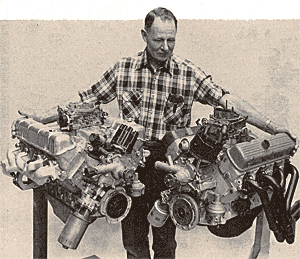 ??Phil Baker lovingly cradles two light weight 215 aluminum engines: Buick (left) and Olds. |
Have you priced a Chevy aluminum small-block lately? Whether procured from factory or aftermarket sources, expect to pay somewhere in the neighborhood of $2500 to $3000. And that merely gets you a bare block. No crank, rods, pistons, camshaft, or valve gear. Not to mention the aluminum cylinder heads, which'll run around $1000, bare. No wonder most of us make do with the old "iron horses."
It doesn't have to be that way. For well under the purchase price of the Chevy bare block, you can build an affordable aluminum V8 with displacements up to 305 cubic inches. Unbelievable? Not really. We're speaking of the 1961-'63 Buick/Olds 215 aluminum motor, an often overlooked granddaddy of the Buick V6 that unfortunately was about 15 years ahead of its time.
With over 3/4 million built, blocks are relatively easy to locate at the local boneyard. Since the motors had cast iron cylinder liners, corrosion is not nearly the problem it was on the linerless Vegas. While it's true that parts on the out-of-production motor are not exactly plentiful, many parts from more modern motors can be substituted with little or no reworking. Two individuals Phil Baker (Baker's Auto Repair, 19552 40th PI. NE, Seattle, WA 98155, 206/363-5088) and Dan LaGirou (D&D Fabrications, P.O. Box 55, Rochester, MI 48063, 313/652-1359)-backyard-build strong-running 215-based motors using amalgamated parts from a variety of engines. Both these individuals also hoard tons of hard-to-find 215 parts. Additionally, D&D offers a completely integrated Vega swap kit that will be covered in detail in a future issue.
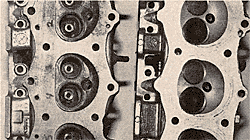
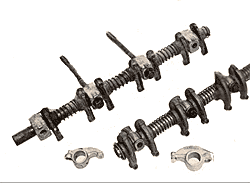
Before there were Buick V6's, there was a lightweight aluminum V8 installed in many Buicks and Olds, and some Pontiacs. Designed originally as an economy engine, it found its way into several quasi-high-performance applications, including Olds' turbocharger applications. Because the aluminum castings cost too much money to produce, the cast-iron Buick V6's replaced it in the economy role, with the 300/ 340 Buicks taking over in the moderate performance category. Later, the tooling was sold to Rover, where a descendant powers that company's products to this day.
There were two major 215 variants: the Buick version and the Olds version. Olds engines may be identified by their angled 5-bolt valve covers; Buicks have flatter 4-bolt covers. (Pontiacs used the Olds versions.) The late British Rover motor is based on the Buick, and except for different accessory mounting bosses on the cylinder heads, it is considered universally, dimensionally, and functionally interchangeable with the Buick design. However, the imported parts are quite expensive.
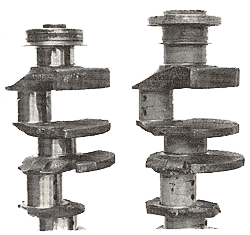
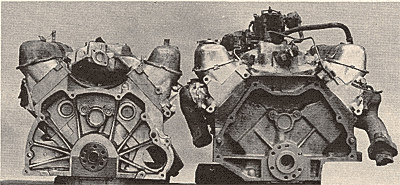
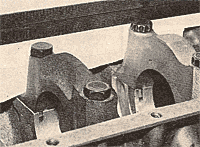
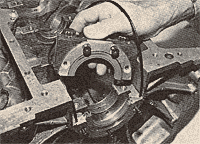
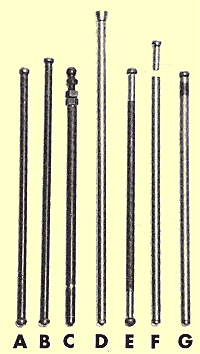
Valve train Substitutions |
||
| Since some valve train parts have been discontinued, and you may wish to add oversize valves, Baker has developed the following valve, valve spring, retainer, and lock combinations. These work with stock or near-stock cams, except for the Buick 300/oversize valve combo, which will work with most aftermarket cams. If using a healthy aftermarket cam in other combinations, inform the cam grinder of the valves being substituted and follow his recommendations for the rest of the valve train combination. Non-stock combinations must be substituted in their entirety of stock parts. | ||
| CYLINDER HEAD | RECOMMENDED SUBSTITUTION | MODIFICATIONS REQUIRED |
| OLDS | Ford 260 valves, springs: retainers, and locks. | Depending on head design (2 or 4-barrel), Ford valves are up to .040-0S, requiring valve seat machining. If stock guides are acceptable for reuse, use '64-'65 260 valve train combinations. If guides unacceptable, use 5/ 16-inch stem '62-'63 Ford 260 with Precision bronze guides, 8-5038. |
| BUICK 215 | Stock or aftermarket replacement parts still available. | |
| BUICK 300 with stock 1.625-intake, 1.313- exhaust valves | Stock or aftermarket replacement parts still available. | |
| BUICK 300 with over-size valves | Exhaust valve-Manley VW 38mm (1.496-inch); intake valve-TRW Volvo V2927X (1.723-inch); 360 Chrysler springs; Chrysler Hemi or Crane 99947 retainer; standard VW locks. | Use Precision 8-5038 guide and grind out seats as necessary. Shim rocker stands to accommodate .040-inch longer Volvo valve. Grind VW valve stem to Volvo height. |
Olds cylinder heads are bolted to the block using six bolts per cylinder, while Buicks use only five bolts. The extra Olds head bolt also retains the Olds rocker shafts. Valve train pieces from the pushrods on up are not interchangeable between the two versions.
Buick blocks don't have the extra head bolt hole drilled in them, and the casting has insufficient thickness to add it. For this reason, an Olds head cannot be installed on a Buick block, although a Buick head (and its associated valve train components) will bolt on an Olds block using only five bolts per cylinder. (Head bolt holes are blind, so water jacket seepage from the empty hole isn't a problem.)
Combustion chamber design also differs, with the Buick using a slightly more open-type design. The Olds head runs better on low-octane gas, but the Buick makes more power in racing trim. Buick has only one type of cylinder head, varying compression by changing piston design. Olds, conversely, uses only one piston, altering compression by varying combustion chamber volume.
Since the Olds had a unique valve train not shared by later Olds engines, while the Buick version gave birth to later Buick V6's and V8's, parts for Buicks are much more plentiful than for the Olds. Also helping tilt the scales in the Buick's favor is its greater production numbers, outnumbering the Olds as it did by about a 3:2 ratio.
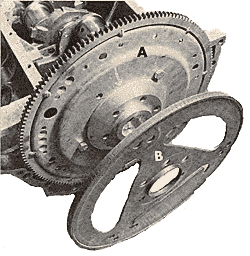
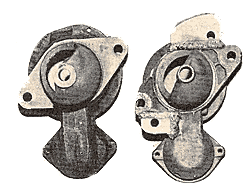
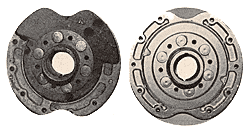
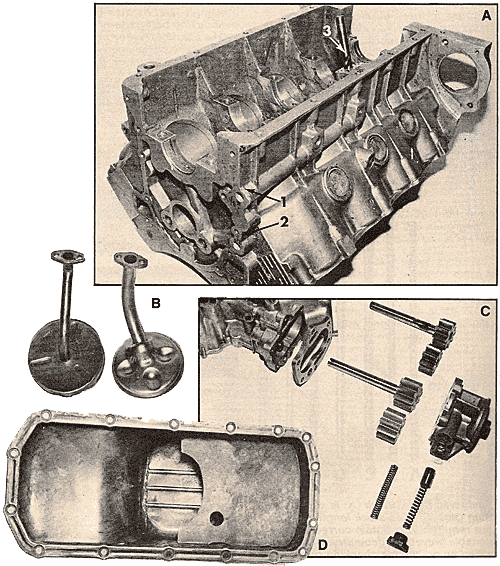
Once unbuttoned, the 215 is not really unfamiliar at all - it looks like a Buick V6 with two extra cylinders. As a Buick V6 relative, it shares that engine's oiling system problems. The same fixes apply to it as on the V6: For high-performance street use, use a bigger pickup, high-capacity oil pump, increased pan capacity, and larger diameter block oiling passages (see photos). For racing, adopt the various external systems developed for the Buick V6.
The bottom-end presents no particular durability problems on the street. For high-performance work, bearing clearance should be kept around .002-.0025. Overbore potential is limited to around .030 (.040 if you're brave) with the stock sleeves. But since there is ample aluminum thickness around the sleeves, much larger bores are possible via the installation of bigger aftermarket sleeves. Baker uses Ohio 231 sleeves, SL 4150 or SL 1121-the former ones being cut in half and used to produce two sleeves for the price of one.
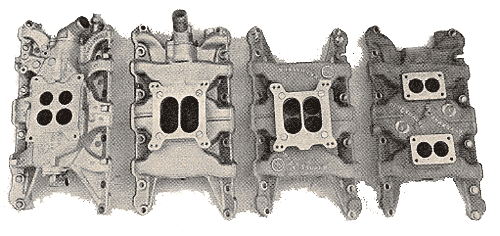
Stock piston availability is severely limited. Only Silvolite (United Engine & Machine, 4909 Goni Rd., Carson City, NV 89701, 702/882-7790) offers new pistons of the dished-type 8.8: 1 CR Buick variety. These can be used with Olds 4-barrel heads, producing a nominal 8.6: 1 ratio. Compression is way too low with Olds 2-barrel heads. If new connecting rods are required, the '67 and earlier Chevy small-block pieces may be substituted. Their 2.0- inch rod journal size is the same as the Olds; however, the Chevy big ends must be shaved approximately .100 inch on their offset sides for correct fit in the narrower 215 journal. Nominal center-to-center lengths are nearly identical- 5.7 inches for the Chevy compared to the 215's 5.660.
| In the combinations listed below, bear in mind that Olds heads fit Olds block only. Small ends of rods and piston pinholes may have to be bored or bushed, as necessary, when using non-stock combinations. Always check deck height and piston-to-valve clearance. Dimension in inches, or fractions thereof. Equivalent pistons other than specific part numbers and manufacturers listed may be substituted. | ||||||
| CID | BORE | STROKE | PISTON | ROD | HEADS | COMMENTS |
| 217 | sTOCK 3.5 +.030 |
Stock 2.8 | 215 +.030 Buick (Silvolite 1718 +.030) | Stock 215 | 215 Buick or Olds 4-barrel | Buick heads: 8.8:1 CR. Olds heads: 2-barrel loses too much compression. 8.6:1 with 4~barrel heads. |
| 245 | 3.736 | Stock 2.8 | 305 Chevy L69 (GM 14044069) | '64-'67 Buick 300 | Olds 2-barrel, Olds 4-barrel, Buick 215 | Install sleeves 3 3/4 X 3/32-inch. This engine for max mileage using 4-barrel Olds or Buick heads. Crower mileage cam a must, 5-speed T-50 or T5 recommended. Hone piston pinhole from .927 to .940. CR: Over 11.5:1 with 4-barrel aids or Buick heads; 9.7:1 with Olds 2-barrel heads. |
| 247 | 3.750 | Stock 2.8 | 265 Chevy flat-top (Perfect Circle 224-2860) | 2" journal early small block Chevy | Olds 2-barrel, Olds 4-barrel, Buick 215 | Olds 2-barrel heads give 2.0:1 lower CR than 4-barrel Olds or Buick heads. 2-barrel Olds CR with .020-thick gasket: 8.54:1. Install sleeves as per 245-cid. |
| 262 | Stock 3.5 | '64-67 Buick 3.4 | 140 Chevy Vega (TRW L2401F) or 267 Chevy (Sealed Power 8456P) | 2" journal early small block Chevy | Olds 2-barrel, Olds 4-barrel, Buick 215 | 140 Vega piston, 4-barrel Olds or Buick heads: 10 1/4-10 1/2:1 CR. 2-barrel heads-2.0:1 lower. 267 Chevy piston: 1/2 ratio lower than Vega. Must deck 267 piston .050. |
| 266 | Stock 3.5 +.030 | '64-'67 Buick 3.4 | 170 Ford 6 +.030 (TRW L2142CF +30 | Stock 215 | Olds 2-barrel, Olds 4-barrel, Buick 215 | For racing or ultimate Crower Mileage System. (Crower CMS-1 cam recommended for mileage.) Hone rod from .875 to .912. CR w/ .040-thick gasket: 4-barrel Olds heads, 13.4:1; Buick heads 13.3: 1; Olds 2-barrel heads, 11.4:1 . |
| 289 | 3.68 | '64-'67 Buick 3.4 | 255 Ford (Sealed Power 9039P) | Stock 215 | '64 Buick 300 | Port heads, use oversize 5/16-stem valves. Install sleeves 3 11/16 X 3/32-inch. Hone rod for pin (.875 to .912). CR 10.38:1 with '64 Buick heads and .040 gasket. |
| 292 | 3.721 | '64-'67 Buick 3.4 | 2800cc For V6. 1/516 Comp. Hght.,+.060 (Perfect Circle 224-1999 +.060) | 2" journal early small block Chevy | Olds 2-barrel, '64 Buick 300 | Different manufacturer's Ford 2.8L V6 piston compression heights may vary; must use 1.516 for this combo. Sleeves as per 289-cid. Hone piston for Chevy pins. CR: 10.8:1 with aids 2-barrel heads and .020 gasket. |
| 298 | 3.736 | '64-'67 Buick 3.4 | 305 Chevy dished LF4 (TRW L2432F) | 2" journal early small block Chevy | Olds 2-barrel, '64 Buick 300 | Install sleeves 3 3/4 X 3/32. Olds 2-barrel heads and .040 gasket: 9.2:1 CR. '64 Buick heads and .040 gasket: 8.7:1 CR. Mopar slant-six modified push rods recommended. |
| 305 | 3.780 | '64-'67 Buick 3.4 | 2.3L Ford Turbo 4 (TRW L2455F) | 2" journal early small block Chevy | '64 Buick 300 | Ultimate combination for street high-performance. Ford turbo piston has .400-thick deck, allowing variable CR's from 8.0-11.5:1 Use oversize 5/16 stem valves, ported heads, big cam, chrome-moly tubular pushrods, '74 Buick 350 HEI distributor. '67-'69 Javelin AFB carb (Carter 4660) has 1 1/16 primaries X 1 9/16 secondaries, bolts to stock intake with no adapter required. |
Moving up to the valve gear, the aftermarket still carries camshafts and lifters, which interchange between Buick and Olds. Cams from the 300/340 engines also work, as do Cloyes Buick V6 double-roller timing chains. As noted above, Olds/Buick valve train similarity ends above the lifters: push rods; rocker arms and shafts; valve springs, keepers and retainers; valve head sizes and valve stem lengths all differ. Olds stock replacement valves are nearly impossible to find. Phil has come up with substitute valve, spring, keeper and retainer packages (see chart). Due to the small combustion chamber and required separate valve seat inserts, radically oversize valves will not fit in stock bore 215's.
Non-stock valves often require different length pushrods to maintain correct geometry with the stock, non-adjustable rocker arms. There are a number of alternatives: Build your own by grafting solid Olds push rod ends onto hollow 225 Mopar slant-six pushrods (photo), use Olds ends on the Chrysler Direct Connection build-your-own-pushrod kit (Chrysler P400?284), or order custom (and expensive) aftermarket pushrods. To determine the new pushrod length, Baker recommends installing the head and used head gasket with the mounting bolts torqued to spec. Rotate the engine to No. 1 firing position so the lifter is on the heel of the cam. Using a fabricated or aftermarket adjustable pushrod, adjust the unit to achieve 0 lash. Add .040-inch more to this derived figure to obtain the required overall length.
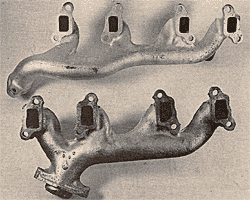
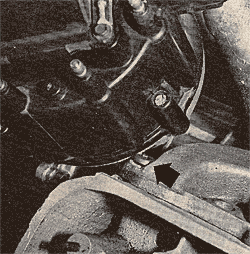
Adjustable rocker arms are required when using solid or roller cams. Kenne-Bell offers trick Buick roller rocker arms and solid lifters. Crane has both solid and roller lifters available. No adjustable rockers are offered for the Olds, but Dave Smith Oldsmobile (112 N. Manchester Ave., Anaheim, CA 92802,714 / 635-3100) does have adjustable pushrods and rebuilt, hard-chromed rocker arm shafts available.
Front covers from later 300/340 engines and Buick V6's are a direct bolt on to the 215, although timing marks may not correspond. This is easily solved by degreeing the balancer. Late model front covers have different oil filter mounting angles, shorter water pumps, and are generally more compact overall, which can be a real advantage in tight engine swap situations.
Engine mount hole spacing is identical to the Buick V6, opening up several intriguing possibilities (215-powered Skyhawk, anyone?). Unfortunately, the bellhousing bolt pattern is unique and not shared by any '64 or later engine. Trans-Dapt offers a replacement bellhousing that works with conventional mechanical linkage. D&D has a bellhousing setup for cable linkage. Both Baker and D&D offer adapters to mate modern automatic transmissions to the 215. D&D uses early-'60s 166-tooth Olds Roto-hydramatic or Buick Dualpath flexplates. When combined with a crank pilot spacer, torque converter spacers, and block spacers, it allows the late GM autos to bolt directly to the Olds using the stock 215 starter. Baker retains a stock 215 flexplate to actuate the starter. A spacer is used behind the 215 flexplate to mate with a Buick TH-350 flexplate, which in turn hooks up to the late torque converter. Naturally, a block spacer/adapter is required as well. All this adaptation is necessary because most later GM starter bodies won't interchange with the 215 block and starter nose. An exception are those 215 starter noses made from aluminum; they'll bolt directly to Vega or Chevette starter bodies.
While the foregoing may sound interesting, you're probably thinking, "215 just isn't enough." Never fear. Phil Baker and D&D have come up with several combinations that enable displacement increases all the way to 305 cubic inches (see chart)! The largest engines require both the big aftermarket sleeves and a Buick 300 crankshaft to increase the stroke by .600-inch (from 2.8 to 3.4 inches). The 300 crank's larger main journals must be turned down to the 215 size. Due to rear main seal differences and longer rear crank overhang, special mods must be per~ formed to the rear of the block. Baker has developed detailed modification plans which are available for a nominal fee, or his machinists, Palmers Four Wheel Drive Center (710 S, E, Everett Mall Way, Suite A, Everett, WA 98204, 206/355-8902), will perform the mods if you send them a block. Basically, Baker modifies the rear" of the block to accept an adapter plate that in turn mates with the 300 crank. D&D also offers an adapter plate.
Critical Blueprinting InformationCYLINDER HEAD VOLUMES'61-'63 Buick 215.....37cc | '64 Buick 300.....54cc | Olds 2-barrel....51cc | Olds 4-barrel.....38cc
HEAD GASKETS |
||||
| Head Type | Holes/Cyl. | Manufacturer/type | Part No. | Compressed thickness |
| Buick 215 | 5 | *Victor/steel shim Fel-Pro/composition |
1174BS 7984 PT |
.020 .040 |
| Olds 215 | 6 | *Victor/steel shim Fel-Pro/composition |
1169BS 7995 PT |
.020 .040 |
| Buick 300** | 4 | Fel-Pro/composition | 8172 PT | .040 |
| *Some late production gaskets are composition: although part number remains the same. Compressed thickness figures do not apply in that case. | ||||
| **Use with all 300 heads on any block, or with any heads when running 3.625-inch or larger bores; punch extra bolt holes in gasket as required. | ||||
To solve the crank overhang problem when using an automatic trans, Baker again uses the dual-flexplate approach (photo), along with a modified starter nose. D&D uses a late Buick V6 flexplate that bolts directly to the 300 crank and meshes with the stock 215 starter. When used with the required trans case-to-block spacer/adapter, the late flexplate bolts right up to the late torque convertor, due to the 300 crank's greater rear overhang. If using a manual trans, D&D recommends a 166-tooth 300 flywheel. The ring gear must be removed and the flywheel's o.d. reduced to accept the 215's 156-tooth ring gear. Use the 215 bellhousing and the trans will bolt right up.
The 300 crank, isn't the only Buick 300 part that's useful for hopping up the 215. While the block is cast-iron, only the 1964 300's had aluminum heads with larger ports and valves that bolt right on to 215 blocks using four head bolts per cylinder (sealing is not a problem). The '64 heads also feature the modern Buick V6/V8-style accessory bosses, allowing the use of the most current mounting brackets, including those designed for the late "shorty" air conditioning compressors.
We'd probably all be driving this combo today if GM hadn't prematurely sold out to Rover. But as hot rodders, we don't have to fret over "might've beens." What the factory didn't do, we can: A 215-based motor will provide superlative handling, fine power-to-weight ratios in today's downsized autos, and won't cost you your life savings to build.
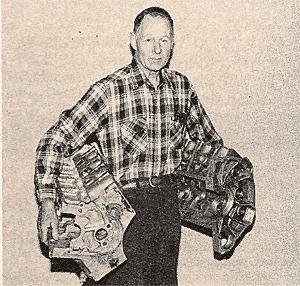 Why not take a few home next time you visit the wrecking yard? |